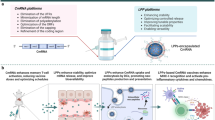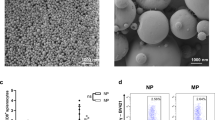Abstract
Genetic vaccination using plasmid DNA presents a unique opportunity for achieving potent immune responses without the potential limitations of many conventional vaccines. Here we report the design of synthetic biodegradable polymers specifically for enhancing DNA vaccine efficacy in vivo. We molecularly engineered poly(ortho ester) microspheres that are non-toxic to cells, protect DNA from degradation, enable uptake by antigen-presenting cells, and release DNA rapidly in response to phagosomal pH. One type of microsphere of poly(ortho esters) that releases DNA vaccines in synchrony with the natural development of adaptive immunity, elicited distinct primary and secondary humoral and cellular immune responses in mice, and suppressed the growth of tumour cells bearing a model antigen. This polymer microparticulate system could, with further study, have implications for advancing the clinical utility of DNA vaccines as well as other nucleic-acid-based therapeutics against viral infections and cancer.
This is a preview of subscription content, access via your institution
Access options
Subscribe to this journal
Receive 12 print issues and online access
$259.00 per year
only $21.58 per issue
Buy this article
- Purchase on Springer Link
- Instant access to full article PDF
Prices may be subject to local taxes which are calculated during checkout





Similar content being viewed by others
References
Liu, M.A. DNA vaccines: a review. J. Internal Med. 253, 402–410 (2003).
Ulmer, J.B. et al. Heterologous protection against influenza by injection of DNA encoding a viral protein. Science 259, 1745–1749 (1993).
Barouch, D.H. et al. Control of viremia and prevention of clinical AIDS in Rhesus monkeys by cytokine-augmented DNA vaccination. Science 290, 486–492 (2000).
Wang, R. et al. Induction of antigen-specific cytotoxic T lymphocytes in humans by a malaria DNA vaccine. Science 282, 476–480 (1998).
Cho, H.J. et al. Immunostimulatory DNA-based vaccines induce cytotoxic lymphocyte activity by a T-helper cell-independent mechanism. Nature Biotechnol. 18, 509–514 (2000).
Dubensky, T.W., Liu, M.A. & Ulmer, J.B. Delivery systems for gene-based vaccines. Mol. Med. 6, 723–732 (2000).
Singh, M. & O'Hagan, D. Advances in vaccine adjuvants. Nature Biotechnol. 17, 1075–1081 (1999).
Zhao, Z. & Leong, K.W. Controlled delivery of antigens and adjuvants in vaccine development. J. Pharm. Sci. 85, 1261–1270 (1996).
Hanes, J., Cleland, J.L. & Langer, R. New advances in microsphere-based singledose vaccines. Adv. Drug Delivery Rev. 28, 97–119 (1997).
Luo, D. & Saltzman, W.M. Synthetic DNA delivery systems. Nature Biotechnol. 18, 33–37 (2000).
Mathiowitz, E. et al. Biologically erodable microspheres as potential oral drug delivery systems. Nature 386, 410–414 (1997).
Tabata, I. & Ikada, Y. Phagocytosis of polymer microspheres by macrophages. Adv. Polym. Sci. 94, 107–141 (1990).
Donnelly, J.J., Liu, M.A. & Ulmer, J.B. Antigen presentation and DNA vaccines. Am. J. Respir. Crit. Care 162, S190–S193 (2000).
Jones, D., Corris, S., McDonald, S., Clegg, J. & Farrar, G. Poly (DL-lactide-co-glycolide)-encapsulated plasmid DNA elicits systemic and mucosal antibody responses to encoded protein after oral administration. Vaccine 15, 814–817 (1997).
Hedley, M.L., Curley, J. & Urban, R. Microspheres containing plasmid-encoded antigens elicit cytotoxic T-cell responses. Nature Med 4, 365–368 (1998).
Singh, M., Briones, M., Ott, G. & O'Hagan D. Cationic microparticles: A potent delivery system for DNA vaccines. Proc. Natl Acad. Sci. USA 97, 811–816 (2000).
Walter, E. et al. Hydrophilic poly(DL-lactide-co-glycolide) microspheres for the delivery of DNA to human-derived macrophages and dendritic cells. J. Control. Release 76, 149–168 (2001).
Wang, D., Robinson, D.R., Kwon, G.S. & Samuel, J. Encapsulation of plasmid DNA in biodegradable poly(D,L-lactic-co-glycolic acid) microspheres as a novel approach for immunogene delivery. J. Control. Release 57, 9–18 (1999).
Anderson, J.M. & Shive, M.S. Biodegradation and biocompatibility of PLA and PLGA microspheres. Adv. Drug Deliv. Rev. 28, 5–24 (1997).
Fu, K., Pack, D.W., Klibanov, A.M. & Langer, R. Visual evidence of acidic environment within degrading poly(lactic-co-glycolic acid) (PLGA) microspheres. Pharm. Res. 17, 100–106 (2000).
Kaech, S.M. & Ahmed, R. Memory CD8+ T cell differentiation: initial antigen encounter triggers a development program in naïve cells. Nature Immunol. 2, 415–422 (2001).
Princiotta, M.F. et al. Quantitating protein synthesis, degradation, and endogenous antigen processing. Immunity 18, 343–354 (2003).
Denis-Mize, K.S. et al. Plasmid DNA adsorbed onto cationic microparticles mediates target gene expression and antigen presentation by dendritic cells. Gene Ther. 7, 2105–2112 (2000).
OHagan, D. et al. Induction of potent immune responses by cationic microparticles with adsorbed human immunodeficiency virus DNA vaccines. J. Virol. 75, 9037–9043 (2001).
Lunsford, L., McKeever, U., Eckstein, V. & Hedley, M.L. Tissue distribution and persistence in mice of plasmid DNA encapsulated in a PLGA-based microsphere delivery vehicle. J. Drug Target. 8, 39–50 (2000).
McKeever, U. et al. Protective immune responses elicited in mice by immunization with formulations of poly(lactide-co-glycolide) microparticles. Vaccine 20, 1524–1531 (2002).
Luo, Y. et al. Plasmid DNA encoding human carcinoembryonic antigen (CEA) adsorbed onto cationic microparticles induces protective immunity against colon cancer in CEA-transgenic mice. Vaccine 21, 1938–1947 (2003).
Klencke, B. et al. Encapsulated plasmid DNA treatment for human papillomavirus 16-associated anal dysplasia: a phase I study of ZYC101. Clin. Cancer Res. 8, 1028–1037 (2002).
Zhu, G., Mallery, S.R. & Schwendamen, S.P. Stabilization of proteins encapsulated in injectable poly (lactide-co-glycolide). Nature Biotechnol. 18, 52–57 (2000).
Tan Y. & Huang L. Overcoming the inflammatory toxicity of cationic gene vectors. J. Drug Target. 10, 153–60 (2002).
Heller, J., Barr, J., Ng, S.Y., Schwach-Abdellaoui, K. & Gurny, R. Poly(ortho esters): synthesis, characterization, properties and uses. Adv. Drug Deliv. Rev. 54, 1015–1039 (2002).
Schwach-Abbellaoui, K., Heller, J. & Gurny, R. Hydrolysis and erosion studies of autocatalyzed poly(ortho esters) containing lactoyl-lactyl acid dimers. Macromolecules 32, 301–307 (1999).
Heller, J. Development of poly(ortho esters): a historical overview. Biomaterials 11, 659–665 (1990).
Chen, J., Eisen, H.N. & Kranz, D.M. A model T-cell receptor system for studying memory T-cell development. Microbes Infect. 5, 233–240 (2003).
Cho, B.K. et al. A proposed mechanism for the induction of cytotoxic T lymphocyte production by heat shock fusion proteins. Immunity 12, 263–272 (2000).
Behr, J.P. The proton sponge: a trick to enter cells the viruses did not exploit. Chimia 51, 34–36 (1997).
Mellman, I. & Steinman, R.M. Dendritic cells: specialized and regulated antigen processing machines. Cell 106, 255–258 (2001).
Probst, H.C., Langel, J., Kollias, G. & van den Broek, M. Inducible transgenic mice reveal resting dendritic cells as potent inducers of CD8+ T cell tolerance. Immunity 18, 713–720 (2003).
Hansen, M.B., Nielsen, S.I. & Berg, K. Re-examination and further development of a precise and rapid dye method for measuring cell growth/cell kill. J. Immunol. Methods 119, 203–210 (1989).
Acknowledgements
The authors thank Daniel Anderson for valuable discussions and assistance and Frank Miskevich for assistance with confocal microscopy. This research was supported in part by a research grant from AP Pharma. C.W. would like to thank the National Institutes of Health for an individual National Research Service Award (1 F32 GM64921-01).
Author information
Authors and Affiliations
Corresponding authors
Ethics declarations
Competing interests
Jorge Heller and Hui-Rong Shen have equity in Pharma, Inc. All the other authors declare no competing financial interests.
Supplementary information
Rights and permissions
About this article
Cite this article
Wang, C., Ge, Q., Ting, D. et al. Molecularly engineered poly(ortho ester) microspheres for enhanced delivery of DNA vaccines. Nature Mater 3, 190–196 (2004). https://doi.org/10.1038/nmat1075
Received:
Accepted:
Published:
Issue Date:
DOI: https://doi.org/10.1038/nmat1075
This article is cited by
-
Construction of nanomaterials based on pH-responsive polymers for effective tumor delivery
Polymer Journal (2021)
-
Diphtheria toxoid nanoparticles improve learning and memory impairment in animal model of Alzheimer’s disease
Pharmacological Reports (2020)
-
Hollow ZIF-8 Nanoworms from Block Copolymer Templates
Scientific Reports (2015)
-
Controlled Endolysosomal Release of Agents by pH-responsive Polymer Blend Particles
Pharmaceutical Research (2015)
-
Advances in fabricating double-emulsion droplets and their biomedical applications
Microfluidics and Nanofluidics (2015)



